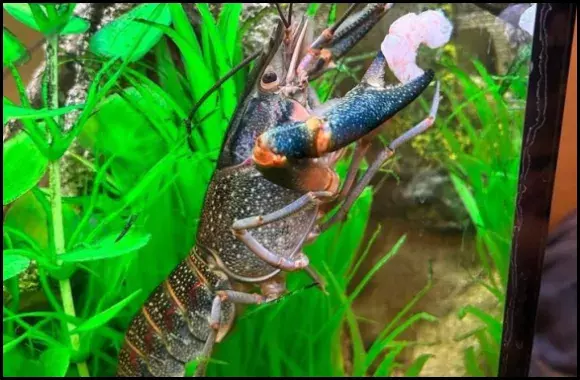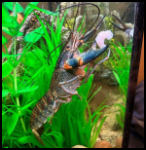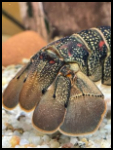





Quick Care Details (Table)
| Livestock Characteristics | Value |
|---|---|
| Care Level | Moderate |
| Temperament | Semi-Agressive |
| Diet | Omnivore |
| Maximum Size | 6 Inches |
| Minimum Tank Size | 30 Gallons |
| Plant Safe | No |
| Temperature Range | 68-85F |
| PH Range | 6.5-7.5 pH |
| KH Range | 6-15 dkh |
| GH Range |
Species Specific Categories
Care Details
- Aquascape: The Blue Moon Crayfish inhabits areas with a lot of plants and wetlands. In an aquarium, it is often seen exploring the tank floor in search of sustenance.
- Substrate: They live in shallow areas of lakes with a lot of plants. However, they have a notable penchant for devouring ornamental live plants.
- Disease Prevention: Leftover feed should be removed by siphoning before fresh food is added. Old exoskeletons should not be removed to improve health.
- Filtration: A well-filtered aquarium with a minimum capacity of 30 gallons is necessary for a single adult due to its size and waste production.
- Lighting: They are mainly active during dawn light, so strong illumination is not necessary.
- Water Flow: Regular water changes are vital due to its waste production.
- Hardiness: These crayfish are hardy and quite adaptable to aquarium conditions.
- Acclimation: They are relatively hardy and acclimate quite easily.
- Expected Lifespan: In captivity, these crayfish can live up to 4 – 5 years, if appropriately cared for.
- Special Requirements: Providing ample hiding places such as rockwork, driftwood, or PVC pipes is crucial, especially when housing multiple crayfish together.
Temperament and Behavior
- Behavior: The Blue Moon Crayfish is a relatively active species. They spend a lot of time exploring the floor of the aquarium in search of food. They engage in displays to indicate dominance.
- Breeding: Supernova Crayfish can breed in captivity. The breeding process is relatively easy, although the young ones grow very slowly.
- Aggression: The Blue Moon Crayfish is known for its aggressive temperament. Males are more aggressive and will likely attack other tank mates. As they reach adulthood, they become relatively territorial.
- Tankmates Compatibility: Fast-moving fish such as Celestial Pearl Danios, Rasboras, Guppies, etc., are recommended as tankmates for the Blue Moon Crayfish. However, caution should be exercised as the crayfish have been known to catch and eat slow, sick, or particularly small shrimp.
- Activity Level: This species is relatively active and spends a lot of time exploring the floor of the aquarium in search of food.
- Schooling or Shoaling Behavior: Crayfish, including the Blue Moon Crayfish, are not known for schooling or shoaling behavior. They are generally solitary creatures.
- Plant Compatibility: Blue Moon lobster are not plant safe. They are known to eat, cut, shred, and uproot everything in the tank. Therefore, it is not recommended to keep them in planted tanks.
Diet and Nutrition
- Dry Foods: The Blue Moon Crayfish can consume a variety of dry foods.
- Frozen Foods: They can eat frozen peas, carrots, and shrimp that are chopped into manageable pieces after thawing.
- Live Foods: In the wild, they consume snails, insects, fish eggs, and small fishes.
- Vegetables: They can eat blanched vegetables like broccoli, cabbages, carrots, cucumbers, lettuce, corn, spinach, peas, squash, leafy greens, etc.
- Algae: They consume algae in their natural habitat.
- Feeding Schedule: Feed them before lights out. Leave their food for 24 hours before removing it.
- Supplemental Foods: They can be fed with a variety of supplemental foods including leaves, plants, crushed snails, earthworms, brine shrimp, dead fish or shrimp.
Tank Parameters
- Tank Size: A minimum 30-gallon, well-filtered aquarium is necessary for one adult. A larger aquarium of 55 gallons or larger can house multiple adults of similar size.
- Tank Length and Measurements: The aquarium should measure 80 cm or more for a pair or small group.
- Species Maximum Size: Generally, they only grow up to 5 – 6 inches in length. However, there are reports that some individuals can measure up to 10 inches.
- Water Temperature: The optimal temperature range is between 68° - 85° F.
- pH (Acidity/Alkalinity): The optimal pH range is between 6.5 - 7.5.
- KH (Carbonate Hardness): The optimal KH range is between 6 - 15 dKH.
- GH (General Hardness): The optimal GH range is between 3 – 25.
- Nitrate (NO3) levels: The nitrate value should not exceed 100 mg/l. However, some crayfish have been kept in tanks with a nitrate level of 20.
History, Popularity, History and Species Variety Details
The History, Popularity and Habitat
History The Blue Moon Crayfish, also known as Cherax boesemani, was named after Dr. Marinus Boeseman. Dr. Boeseman was honored for his contributions to the scientific knowledge of freshwater crayfish of the genus Cherax in Irian Jaya (West New Guinea), Indonesia, and as the first collector of this species. The Blue Moon Crayfish started showing up in the aquarium trade around the early 2000s.
Popularity The Blue Moon Crayfish is popular as a freshwater aquarium pet across Asia, Europe, and North America. It’s not very common in the aquarium trade, but these crayfish can be easily recommended even for beginners. They are hardy, easy to care for, and can breed in captivity. Their variable blues, reds, and oranges are the predominant carapace colors, which has led to extensive selective breeding to create new commercial strains, with names such as Blue Moon, Supernova, Papuan red, tricolor, and Red Brick.
Habitat Cherax boesemani is a crayfish endemic to West Papua, Indonesia. This species can be found only in the Ajamaru Lakes and the Ajamaru River, which belong to the Kais River drainage. These crayfish live in shallow areas (rarely more than 10 feet or 3 meters) of the lakes with a lot of plants, wetlands, and tributaries of the lakes. These lakes have hard, mineral-rich water with neutral pH.
- Blue Moon: This variation is named for its striking blue coloration.
- Supernova: This variation is known for its vibrant and varied coloration.
- Papuan Red: This variation has a dominant red coloration.
- Tricolor: As the name suggests, this variation exhibits three distinct colors.
- Red Brick: This variation has a deep, brick-red coloration.
Common Tank mates
Fast-Moving Fish: Species such as Celestial Pearl Danios, Rasboras, and Guppies are recommended as they are quick and can easily avoid the crayfish.
- Tetras: Tetras are active, energetic schooling fish that populate the tank’s middle area. They thrive in larger groups and are hard to catch, especially if they have a lush ecosystem with plenty of hiding areas.
- Rasboras: Rasboras follow the same recipe that tetras use. They rely on group strength, speed, and hiding to avoid any predators that may target them.
- Hatchet Fish, Danios, Neon Tetras, Rosy Red Minnows: These species are also suitable tank mates for blue crayfish.
Male gender vs Female gender (Sexual Dimorphism)
Sexual dimorphism, the physical difference between males and females of the same species, is present in the Blue Moon Crayfish (Cherax boesemani). However, it’s not as pronounced as in some other species.
In general, both sexes of Cherax, the genus to which the Blue Moon Crayfish belongs, are selective with their copulation partners. Females tend to choose males with a larger central mass (abdomen and tail) and cheliped. Males tend to select copulation partners who have larger body sizes and are virgins, as opposed to females who were more dominant or had symmetrical chelipeds.
For the Blue Moon Crayfish specifically, the claws do not exhibit sexual dimorphism and are equal in form and size. This means that both male and female crayfish have similar claw structures, making it difficult to distinguish between the sexes based on this characteristic alone.
Back to topBreeding
The Blue Moon Crayfish, scientifically known as Cherax boesemani, is a species that can breed in captivity. The breeding process is relatively straightforward, but it’s important to note that the offspring, often referred to as ‘fry’, grow at a very slow pace.
The breeding process begins when a male and female crayfish mate. The male deposits sperm into the female, who then carries the fertilized eggs in her swimmerets, located on the underside of her tail. During this period, the female is said to be “in berry” because the eggs resemble small berries.
After a gestation period, the eggs hatch and the tiny crayfish emerge. At this stage, they are extremely small and vulnerable, so providing them with plenty of hiding places in the tank is crucial. It’s also important to feed the fry a diet rich in nutrients to support their growth. This can include small pieces of fish, shrimp, vegetables, and commercial crayfish food.
As the fry grow, they go through a series of molts, shedding their exoskeleton to allow for further growth. It’s important not to remove these shed exoskeletons from the tank, as the crayfish will often consume them to regain valuable nutrients.
The slow growth rate of the Blue Moon Crayfish fry means that it can take quite some time for them to reach adulthood. However, with proper care and attention, they can grow into beautiful, healthy adults, making the breeding process a rewarding experience for any aquarium enthusiast.
Back to topFrequently Asked Questions
How big does the Blue Moon Crayfish get?
The Blue Moon Crayfish can grow up to 5 – 6 inches in length. However, there are reports that some individuals can measure up to 10 inches.
What kind of habitat does the Blue Moon Crayfish need?
They thrive in a tank size of around 30 gallons, with optimal temperatures between 75 – 88 °F and a pH of 7.0 – 8.0. They prefer shallow areas with plenty of plants.
What does the Blue Moon Crayfish eat?
The Blue Moon Crayfish is omnivorous. They will eat algae and detritus or possibly even one of your fish.
Can the Blue Moon Crayfish breed in captivity?
Yes, the Blue Moon Crayfish can breed in captivity. The breeding process is relatively easy, although the young ones grow very slowly.
What are some suitable tank mates for the Blue Moon Crayfish?
Fast-moving fish such as Celestial Pearl Danios, Rasboras, and Guppies are recommended as tankmates for the Blue Moon Crayfish. However, caution should be exercised as the crayfish have been known to catch and eat slow, sick, or particularly small shrimp.
Will The Blue Moon Lobster Eat Fish In My Aquarium?
These crayfish are more friendly as far as crayfish go, but keep in mind they are opportunistic feeders. The Rule of thumb is that if he is able to catch them, then he will likely eat them. You should aim for very fast fish or armor-plated larger fish.

